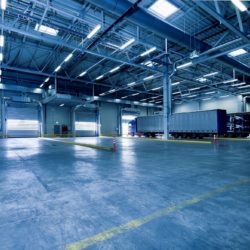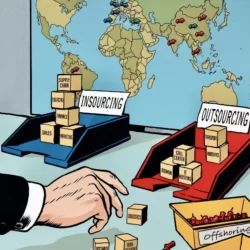Boxification debate forces real estate industry to be realistic and creative

In the logistics real estate industry, there is a growing realization that resistance to XXL distribution centres is here to stay. Not only because of the amount of space they take up and their environmental impact, but also because of the migrant workers who they employ. At a recent conference on logistics real estate in the Netherlands organized by Spryg, property developers and investors appeared to have accepted that their new-build plans must contribute to the wider prosperity of the surrounding area. But one question they seem to be forgetting is whether any land will actually become available for those new construction plans.
By Marcel te Lindert
Along the A59 motorway where the congress is taking place, the municipality of Waalwijk still has 76 hectares available for large-scale logistics. Unlike before, that land will no longer automatically go to the highest bidder, Mayor Sacha Ausems says in her opening speech. ‘We no longer select solely on economic added value, but also look at the real contribution being made for the businesses and inhabitants of Waalwijk. The social challenges are very big and I think real estate developers should contribute to solving them. Not because they have the necessary innovative strength and implementation capacity, but because they have a duty to do so.’
Before that, Ausems had outlined what those social challenges are. Like other parts of the Netherlands, Waalwijk faces power grid overload and congested roads. ‘I don’t know if you’re aware of it, but large-scale logistics also puts extra pressure on our local facilities. Almost half of all healthcare or security-related incidents in Waalwijk involve a migrant worker,’ states the mayor, who wants to select companies for their contribution to broader prosperity. ‘We are going to challenge them to join us in thinking about this constructively. Because we have to work together for a future-proof logistics sector… in terms of support, in terms of innovation and in terms of social care.’
No more Chinese junk
During the congress – the tenth edition by Spryg Real Estate Academy – it appears that the real estate sector has got the message. At least that is the case for Dilas, an association of developers, investors and builders of logistics real estate. ‘We are reaching out and advocating a strong consideration framework,’ says Tim Beckmann, CEO of real estate developer Intospace and Dilas board member. ‘Don’t simply state in advance that you don’t want any more buildings containing Chinese junk, but look at the company’s social impact. What contribution does it make to the circular economy? Is the building energy-neutral and does it fit in with its surroundings? Then every company can make the choice to be a good entrepreneur.’
Besides Waalwijk, the city of Lelystad is also subjecting the opening of a new XXL distribution centre to stricter conditions. ‘The days are behind us when we sold our land to the first ‘box builder’ who asked. Call that hindsight,’ claims Onno Zwart, director at Ontwikkeling Maatschappij Airport Lelystad Almere (Omala). ‘We once sold land for a very large logistics project, and everyone in Lelystad now asks themselves “Should we have done that?”. Now, we think critically about the architecture of a new building, the activities that will take place there and the social impact it will have. But the question is whether we can sustain that. If ASML were to approach us tomorrow wanting to build a big grey box, everyone would be rolling out the red carpet.’
700 additional hectares per year
One key question that the logistics real estate sector seems to ignore concerns the availability of land for large-scale logistics. René Buck puts this issue on the table. ‘In the discussion today, everyone seems to assume that we can still build new XXL distribution centres,’ states the CEO of consultancy BCI Global. ‘But if you look at all the provincial administrative agreements, that remains to be seen. If the space is not created, it makes no sense to keep discussing the social impact of new distribution centres.’
Buck knows what he is talking about. Earlier in the day, he had presented an overview of the logistics real estate market. In doing so, he referred to the Dutch Ministry of Economic Affairs, which expects the amount of land occupied by business to grow from 2.6% currently to 3.0% by 2050. ‘That means we need an extra 700 hectares every year until 2030. And an additional 570 hectares every year from 2030 to 2050. We cannot assume that this extra space will come. We face all kinds of barriers that make it difficult to find space for logistics,’ says Buck, referring to the nitrogen, water and energy issues and the growing social resistance to new business parks, among other things.
1% more space for the built environment
Beckmann seems unable to imagine that the land needed for large-scale logistics might not become available. ‘The built environment takes up 13% of the Netherlands, with businesses accounting for 2.6%. We use 42% of our space for cows. If we free up 1% more space for the built environment, we will create space for 1 million homes. As the Netherlands, we should want to make a choice: what kind of economy do we want to be, and how do we want to earn our money? With an extra 1 per cent, we no longer need to discuss space, only the quality of how it is used.’
Nevertheless, at the end of the conference, Waalwijk councillor Frank Spierings makes an appeal for more efficient use of the few square metres that are currently available. ‘In our city we’re stuck with some old industrial companies, and we are only allowed to build new houses on empty spaces within built-up areas. So if we can install SMEs from the city on the roof of new XXL distribution centres, perhaps with a padel court next door, we can free up space in the city to create a whole new residential area.’
Padel courts on the roof
The call for creative solutions is echoed by Peter van der Maas, Executive Vice President of DSV Solutions Benelux. This logistics provider opened its first Dutch multistorey distribution centre in Venlo this spring. ‘We have a limited number of square metres and therefore, as an industry, we have a duty to use them efficiently. Think about creating housing on the roof. Or maybe we should construct our distribution centres 14 metres underground so we can put padel courts or tennis courts on the roof. I understand that this is difficult in much of the Netherlands, given the soil conditions, but there are certainly possibilities.’










